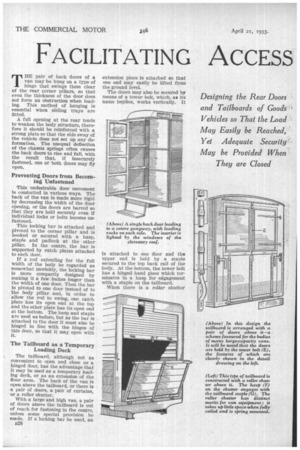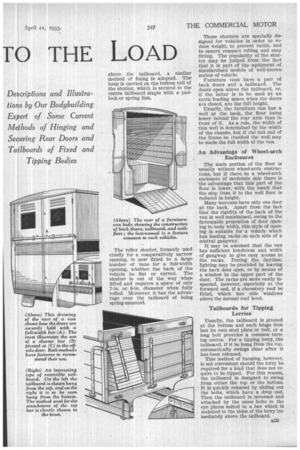FACILITATING ACCESS TO THE LOAD
Page 42

Page 43

If you've noticed an error in this article please click here to report it so we can fix it.
THE pair of back doors of a van may 'be hung on a type of hinge that swings them clear of the rear corner pillars, so that even the thickness of the door does not form an obstruction when loading. This method of hanging is essential when sliding trays are fitted.
A full opening at the rear tends to weaken the body structure, therefore it should be reinforced with a strong plate so that the side sway of the vehicle does not set up any deformation. The unequal deflection of the chassis springs often causes the back doors to rise and fall, with the result that, if insecurely fastened, one or both doors may fly open.
Preventing Doors from Becoming Unfastened This undesirable door movement Is combatted in various ways. The back of the van is made more rigid by decreasing the width of the door opening, or the doors are barred so that they are held securely even if Individual locks or bolts become unfastened.
This locking bar is attached and pivoted to the corner pillar and is hooked or secured with a hasp, staple and padlock at the other pillar. In the centre, the bar is supported by catch plates attached to each door.
If a rod extending for the full width of the body be regarded as somewhat unwieldy, the locking bar is more compactly designed by making it a few inches longer than the width of one door. Then the bar is pivoted to one door instead of to the body pillar, and, in order to allow the rod to swing, one catch plate has its open end at the top • and the other plate has its open end at the bottom. The hasp and staple are used as before, but as the bar is attached to the door it must also be hinged in line with the hinges of this door, so that it may open with it.
The Tailboard as a Temporary Loading Deck
The tailboard, although not as convenient to open and close as a hinged door, has the advantage that it may be used as a temporary loading deck, or as an extension of the floor area. The back of the van is open above the tailboard, or there is a pair of doors, a pair of curtains, or a roller shutter.
With a large and high van, a pair of doors above the tailboard is out of reach for fastening in the centre, unless some special provision be made. If a locking bar be used, an extension piece is attached so that one end may easily be lifted from the ground level.
The doors may also be secured by means of a tower bolt, which, as its name implies, works vertically. It is attached to one door and the upper end is held by a staple secured to the top back rail of the body. At the bottom, the tower bolt has a hinged hand piece which terminates in a hasp for engagement with a staple on the tailboard.
When there is a roller shutter above the tailboard, a similar method of fixing is adopted. The hasp is carried on the bottom rail of the shutter, which is secured to the centre tailboard staple with a: padlock or spring link.
The roller shutter, formerly used chiefly for a comparatively narrow opening, is now fitted to a large number of vans for a full-width opening, whether the back of the vehicle be flat or curved. The shutter is out of the way when lifted and requires a space of only _7-in. or 8-in, diameter when fully rolled. Moreover, it has the advantage over the tailboard of being spring-mounted. These shutters are specially designed for vehicles in order to reduce weight, to prevent rattle, and to ensure compact rolling and easy fitting. The popularity of the shutter may be judged from the fact that it is part of the equipment of standardized models of well-known makes of vehicle.
Furniture vans have a pair of back doors and a tailboard. The doors open above the tailboard, or, if the latter is to be used as an extraloading space when the doors are closed, are the full height.
Usually, the furniture van has a well •at the back, the floor being lower behind the rear axle than in front of it. As a rule, the width of this well is determined by the width of the chassis, but if the tail end of the frame be cranked the well may be made the full width of the van.
An Advantage of Wheel-arch Enclosures
The main portion of the floor is usually without wheel-arch obstructions, but if there be a wheel-arch enclosure of moderate size there is 'the advantage that this part of the floor is lower, with the result that the step from it to the well floor is reduced in height.
Many ■boxvans have only one door at the back. Apart from the fact 'that the rigidity of the back of the van is well maintained, owing to the favourable proportion of door opening to body width, this style of opening is suitable for a vehicle which has loading racks on each side of a central gangway.
It may be assumed that the van has sufficient headroom and width of gangway to give easy access to the racks. During the daytime, lighting may be provided by leaving the back door open, or by means of a window in the upper part of the door. The racks are more easily inspected, however, especially at the forward end, if a clerestory roof be fitted, 'which has side windows above the normal roof level.
Tailboards for Tipping Lorries
Usually, the tailboard is pivoted at the bottom and each hinge iron has its own stud plate or bolt, or a long bolt provides a common turning centre. For a tipping lorry, the tailboard, if it be hung from the top, automatically swings clear after it has been released.
This method of hanging, however, is not convenient should the lorry be required for a load that does not require to be tipped. For this reason, the tailboard is designed to swing from either the top or the bottom. It is quickly released by sliding out the bolts, which have a drop end. Then the tailboard is reversed and attached by the same bolts to the eye plates bolted to a bar which is socketed to the sides of the lorry immediately above tile tailboard.




























































































